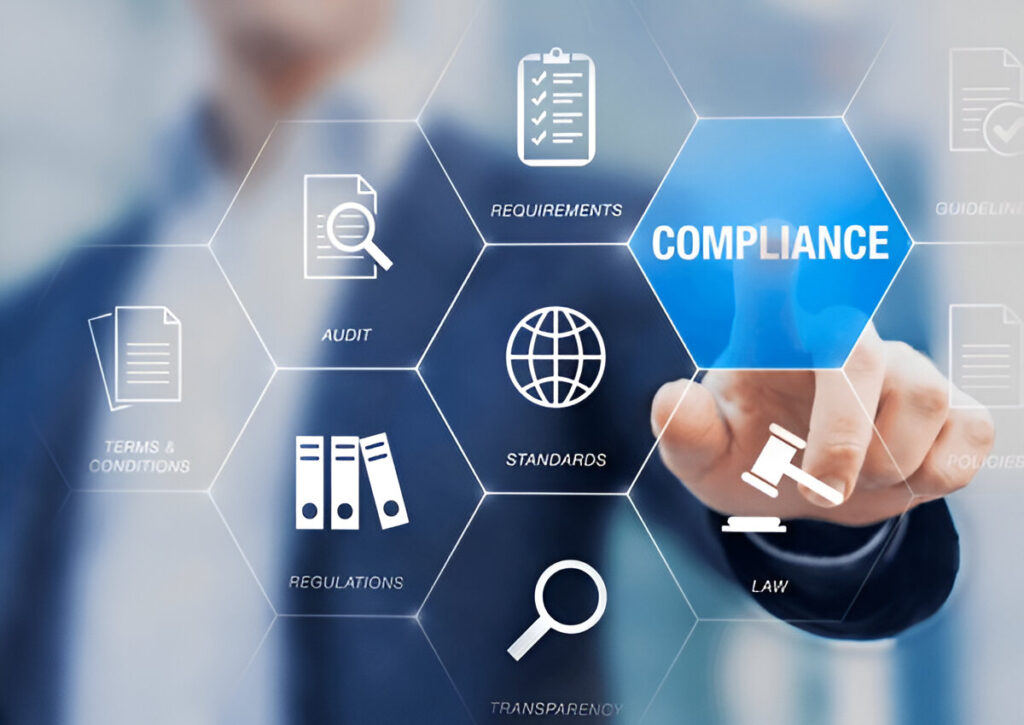No one wants to get caught off guard by a compliance failure — especially when the stakes include fines, legal troubles, or damaged trust. Whether you’re leading a healthcare network or overseeing financial operations, compliance audits aren’t just routine — they’re essential.
But here’s the problem: many organizations wait until an audit is looming before scrambling to get their records in order. That’s risky. A well-prepared, repeatable compliance audit process can uncover issues early. It can strengthen internal controls and prove that your business meets compliance requirements before regulators come knocking.
This guide lays out a practical, easy-to-follow compliance audit procedures checklist to help you plan, perform, and document an effective audit. Whether you’re conducting an internal audit or preparing for an external review, you’ll find clear steps and real-world advice designed to make the process smoother and more reliable.
Let’s get started.
What Is a Compliance Audit?
A compliance audit is a detailed review that checks whether an organization is following the laws, regulations, and internal policies that apply to its business.
The purpose of a compliance audit is to look at how well your processes, records, and actions match up with required standards. This could include federal or state laws, industry-specific rules like the Health Insurance Portability and Accountability Act (HIPAA), or internal procedures your team is expected to follow.
The audit can be done by your own team (internal audit) or by an outside party (external audit). In either case, the goal is the same: to find gaps, reduce risk, and show that your organization is doing things the right way.
A compliance audit usually focuses on:
- Policies and procedures — Are they current, and are people following them?
- Documentation — Can you prove what you’re doing?
- Regulatory requirements — Are you meeting legal obligations?
- Internal controls — Are your systems preventing errors and violations?
Audits vary by industry, but the process is similar across most organizations. Audit reports help you catch mistakes and build trust with customers and partners.

Common Types of Compliance Audits
Not all compliance audits are the same. The type of audit you conduct depends on your goals, industry, and regulatory requirements. Some audits are handled in-house. Others involve third-party evaluators. Some are scheduled, while others happen with little notice.
Below are three of the most common types of compliance audits — and what makes each one unique.
Internal Audits
These audits are conducted by your own organization. It is often the first step in maintaining ongoing compliance. The process is led by a compliance officer, internal auditor, or risk management or audit teams. It helps you stay ahead of potential problems by identifying gaps before regulators or outside parties get involved.
The key goals of an internal audit include:
- Evaluating internal controls and policies
- Checking for non-compliance with regulations or procedures
- Recommending improvements to business processes.
External Audits
These audits are conducted by independent third parties. These may include government agencies, industry regulators, or certified public accountants (CPAs). An external audit provides unbiased verification that your compliance processes meet established laws and regulations.
Unlike internal audits, external ones are often formal. They are required for:
- Regulatory certifications (e.g., HIPAA, GDPR, Payment Card Industry standards)
- Granting eligibility or funding (common in nonprofits)
- Financial reporting or stakeholder assurance.
Surveillance Audits
Surveillance audits are periodic follow-up audits that ensure compliance over time. These are common in industries with ongoing certification standards, such as ISO 9001 or SOC 2.
Unlike full audits, surveillance audits typically:
- Focus on specific areas or high-risk processes
- Verify continued compliance, rather than evaluating everything from scratch
- Occur annually or semi-annually, depending on the compliance framework.
Successful Compliance Audit Procedures: Step-by-Step Guide
A successful compliance audit starts with a plan. To get accurate results and reduce stress, you need a step-by-step process that covers every stage of the audit, from prep to reporting.
The following steps outline a complete compliance audit checklist you can adapt to fit your organization.
Identify the Areas That Require Auditing
Start by pinpointing the areas of compliance most relevant to your business. These may include:
- Financial statements and reporting
- Data privacy (e.g., GDPR, HIPAA)
- HR practices
- Safety protocols
- Industry-specific regulations.
This step ensures your internal or external audit stays focused. You don’t need to review everything at once. Look at past audit findings, risk-prone areas, or recent changes in laws and regulations. This keeps the audit targeted and manageable.
Establish the Scope of the Audit
Once you know the audit objectives, define its scope clearly. This includes:
- Which departments or teams are involved
- Time period to be reviewed
- Standards, regulations, or internal policies being evaluated.
A well-defined scope of a compliance audit prevents confusion later on. It also helps the audit team stay on track and avoid duplicate efforts.
Conduct a Risk Assessment
Not all risks carry the same weight. That’s why a risk assessment is crucial before the audit begins. It helps to:
- Prioritize audit areas based on risk level
- Identify where non-compliance is most likely
- Allocate resources more effectively.
Common risk indicators include prior violations, lack of documentation, frequent staff turnover, or system changes. This step sharpens your final audit focus and improves its value.
Create an Audit Calendar
Audits don’t happen in a vacuum. Creating an audit calendar helps you plan ahead. It lets you avoid last-minute stress and maintain a regular schedule.
Your calendar should include:
- Start and end dates
- Key milestones
- Staff assignments
- Review deadlines.
For larger organizations or internal compliance auditors, this calendar also supports ongoing compliance by mapping audits across the year. It can be especially helpful if you’re managing multiple types of audits to stay compliant.
Review Compliance Policies, Processes and Controls
At this stage, you can dig into the finer details. This is the heart of the audit process. You should review all the relevant:
- Compliance policies (are they current?)
- Business processes (are they being followed?)
- Internal controls (are they effective?).
Check for missing documentation, outdated procedures, or areas where policies don’t match what’s happening on the ground. The goal is to ensure that your systems aren’t just compliant, but are actually working.
Analyse, Report and Suggest Corrective Actions
Once your review is complete, gather your findings and put them into a clear, organized audit report. This report should:
- Outline areas of non-compliance
- Explain how and why each issue occurred
- Recommend corrective actions with timelines and ownership
- Include supporting data or evidence.
Share the report with stakeholders, leadership, or regulators. Most importantly, follow up. Make sure the report doesn’t just sit in a folder — it should lead to real change.

Is Conducting a Compliance Audit Important?
Yes, it is. Conducting an audit is critical for any organization that wants to stay in good standing, avoid penalties, and build trust. Audits may look like just a box to check, but they’re more than that. Conducting the audits is a key part of running a responsible, risk-aware business.
The following table helps you understand why regular compliance audits are necessary:
| Reason | Why It Matters |
| Adherence to Regulatory Compliance | Confirms your organization is following laws, industry standards, and internal and external policies. Helps maintain certifications and avoid penalties to ensure ongoing compliance. |
| Managing Risks | Identifies weak spots in policies or operations before they turn into compliance issues. Strengthens your risk management strategy. |
| Increased Operational Efficacy | Uncovers inefficiencies and outdated compliance practices. Leads to streamlined workflows and better accountability. |
| Fraud and Data Protection | Helps detect fraud, improper access, or gaps in data privacy. Ensures strong internal controls to safeguard sensitive information and prevent data breaches. |
| Business Continuity | Supports long-term stability by identifying issues in recovery plans and system access. Prepares your organization for unexpected disruptions. |
Compliance Audit Best Practices to Follow
Even with a strong compliance audit process, how you manage and maintain it over time makes a big difference. The following best practices can help your team stay organized, reduce errors, and build a long-term culture of accountability.
Whether you’re conducting an audit for the first time or running regular assessments across multiple departments, these tips will be of help.
Delegate Effectively
A successful and effective compliance audit requires input from multiple people. While a particular compliance officer or internal auditor may take the lead, you should also assign roles for others to perform tasks like:
- Who gathers documentation?
- Who reviews policies?
- Who leads interviews?
When tasks are divided early, the audit runs faster and with fewer delays. This also ensures that each team member knows their responsibilities and contributes accurate information.
Create a Culture of Compliance
Compliance isn’t just about audits — it’s about how your organization operates every day. That’s why it is important to create a culture of ensuring compliance with regulations. You can make it a part of your team’s mindset by:
- Offering regular training on information about compliance
- Encouraging questions and reporting
- Rewarding attention to detail.
A strong compliance culture makes completing the audits easier. Staff are more likely to follow procedures, maintain documentation, and flag issues before they become bigger problems.
Stay On Top of Regulatory Changes
Regulatory requirements change often, especially in industries like healthcare, finance, and data protection. This means your risk management procedures should keep up as well. To show compliance with updated regulations, you should assign someone (or a team) to monitor updates to compliance standards that affect your business. Subscribe to alerts from key agencies. Join industry groups. Adjust your policies and audit procedures regularly to reflect those changes.
Being proactive helps you stay compliant without last-minute scrambles.
Prioritize Self-Assessment
You shouldn’t wait for a formal audit to check if your team is on track. Instead, try conducting self-assessments to catch problems early. They’re especially useful before an external compliance audit or after a major policy or system change.
A quarterly or semi-annual internal review can uncover small issues before they grow. It can save you time, money, and risk.
Leverage Automation
Manual audits can be time-consuming. They are also prone to human error. As such, consider using audit management tools to automate key tasks like:
- Scheduling audit dates
- Sending document requests
- Tracking corrective actions
- Generating audit reports.
Automation improves accuracy, speeds up the audit cycle, and ensures compliance processes are documented consistently.
FAQs on Compliance Audit Processes
What Are the Elements of a Compliance Audit?
The elements include planning, risk assessment, scope definition, documentation review, fieldwork, reporting, and corrective action tracking.
Why Is Documentation Necessary During a Compliance Audit?
Documentation proves that policies are followed and controls are in place. It supports findings and helps meet regulatory standards.
What Are the Principles of Compliance Audit?
Objectivity, transparency, consistency, and evidence-based evaluation. Audits must follow specific procedures and rely on verified data.
How Often Should a Compliance Audit Be Conducted?
At least once a year. High-risk industries or changing regulations may require more frequent audits, such as quarterly or semi-annually.
Conclusion
A strong compliance audit that meets the requirements can protect your business. It helps you improve operations and prepare for the future. Whether you’re managing sensitive data, ensuring HIPAA or CMMC compliance, or just trying to stay ahead of risk, a well-structured audit keeps you in control.
Ready to tackle compliance regulations requirements and stay audit-ready year-round? Get in touch with Crown Computers! We have been helping small and mid-sized businesses secure systems and meet the demands of compliance programs for 25 years. From following all the necessary steps to ensuring continued support, we will be with you every step of the way.
Call us at +1-858-483-8770 to schedule a consultation and learn how we can help before your next audit occurs.
